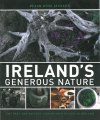![Ireland's Generous Nature Ireland's Generous Nature]()
Click to have a closer look
About this book
Customer reviews
Biography
Related titles
About this book
Peter Wyse Jackson's Ireland's Generous Nature is the first ever comprehensive account of the historical and present-day uses of wild plant species in Ireland. It records a wealth of traditional knowledge about Irish plant use, knowledge that has been disappearing fast. More than 1500 wild plants are detailed in a systematic list, which gives both their Irish and English names. Many historical references have been included from a wide range of Irish literature.
This lively and scholarly book shows how plants have been used in virtually every aspect of human life in Ireland: food, clothes, medicine, construction, drinks, veterinary medicine, human health and beauty, and even death. Ireland's Generous Nature is richly illustrated with photographs, as well as botanical paintings by Irish artist Lydia Shackleton (1828–1914). Its blend of scientific and historic facts with myths, superstition and tales offers an unrivalled account of the rich heritage of Irish plants.
Set offshore at the far fringe of Europe, its historic subsistence rural culture so long remote from industrial development or bourgeois mores, Ireland should offer an encyclopedic heritage of the use of wild plants as food and medicine, for everyday utility or symbolic ritual. For early centuries, indeed, the importance of plant knowledge was tempered as much by a continuing pagan respect for nature as by the herb gardens of the many monasteries.
How this knowledge was lost or rejected after the Famine and in the drive for modernity and prosperity is just one thread of Peter Wyse Jackson's epic exploration of Ireland's ethnobotanical heritage. It has not been an easy venture, pursued over years and to many sources. One of the richest has been the remarkable folklore collection held in University College, Dublin, much of it in the Irish language. Loss of Irish in the island as a whole, and hostile attitudes bred through clumsy schooling, have helped to rob modern rural culture even of names of plants, let alone their many virtues and uses.
In an increasingly synthetic and digital world, however, there remains, or has revived, an intuitive need for reconnection with plants. From the greener reaches of the internet to the new allotments and communal city gardens of Dublin – even, indeed, the current fascination with culinary herbs and spices – this renewal of curiosity adds much value to Ireland's Generous Nature, alongside its obvious beauty and great ethnobotanical worth. More than half of the 925 native plants of this island have been useful to its people, but nowhere, until now, have their stories been gathered together so systematically, both for Irish readers and the wider cultural and scientific audience.
Customer Reviews
Biography
Dr. Peter Wyse Jackson is President and Director of the Missouri Botanical Garden in St Louis and George Engelmann Professor of Botany at Washington University, St Louis. He formerly held positions as Secretary General of Botanic Gardens Conservation International, based at Kew in London, and as the Director of the National Botanic Gardens in Glasnevin, Ireland, before moving to his present position in 2010. He holds a degree in botany and a PhD from Trinity College Dublin and has published widely on Irish botany, botanic gardens and plant conservation.
By: Peter Wyse-Jackson(Author)
750 pages, colour photos, ccolour & b/w illustrations
"Set offshore at the far fringe of Europe, its historic subsistence rural culture so long remote from industrial development or bourgeois mores, Ireland should offer an encyclopedic heritage of the use of wild plants as food and medicine, for everyday utility or symbolic ritual. For early centuries, indeed, the importance of plant knowledge was tempered as much by a continuing pagan respect for nature as by the herb gardens of the many monasteries [...] More than half of the 925 native plants of this island have been useful to its people, but nowhere, until now, have their stories been gathered together so systematically, both for Irish readers and the wider cultural and scientific audience."
– Michael Viney, Author and Columnist for The Irish Times Weekend Review








































